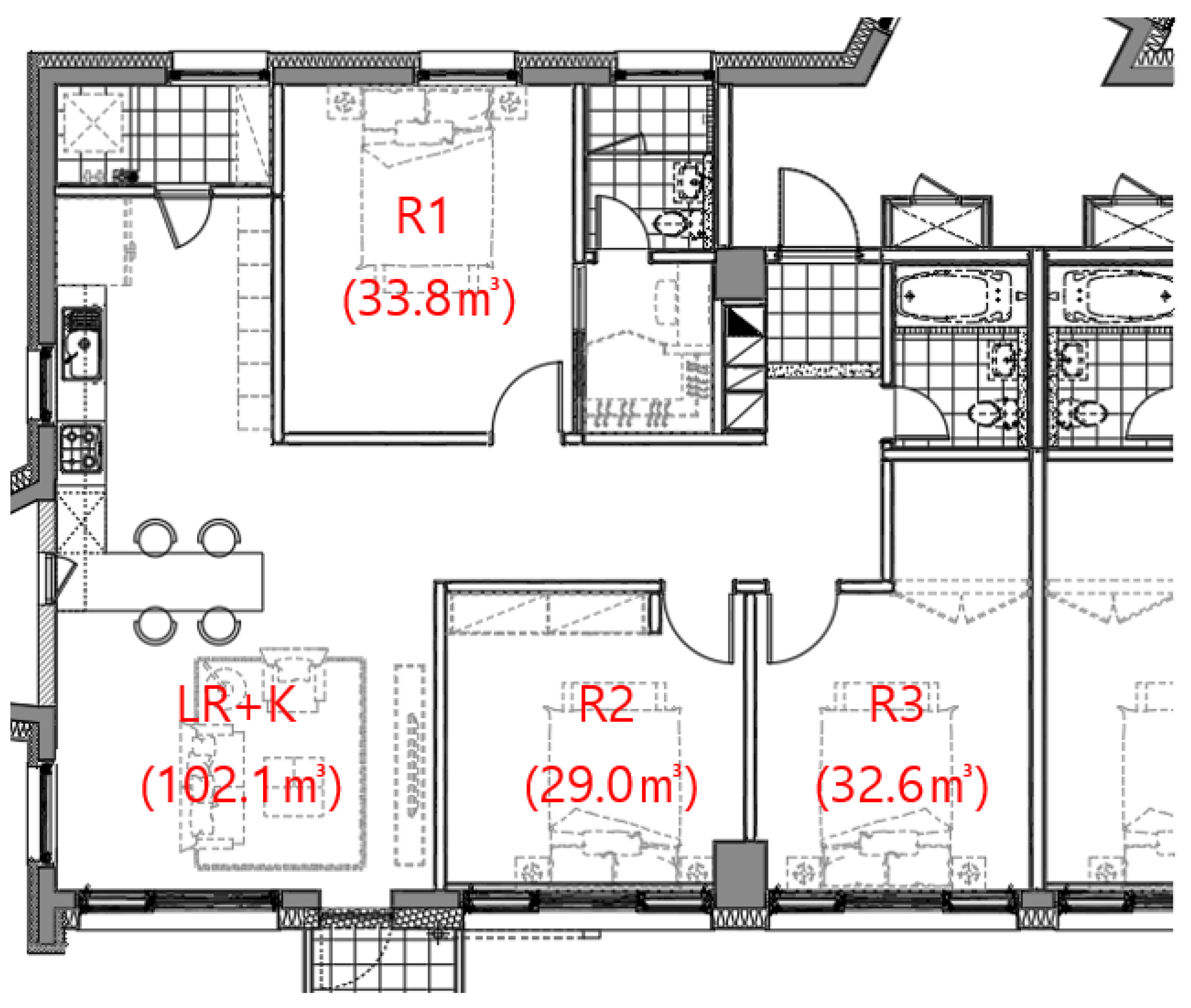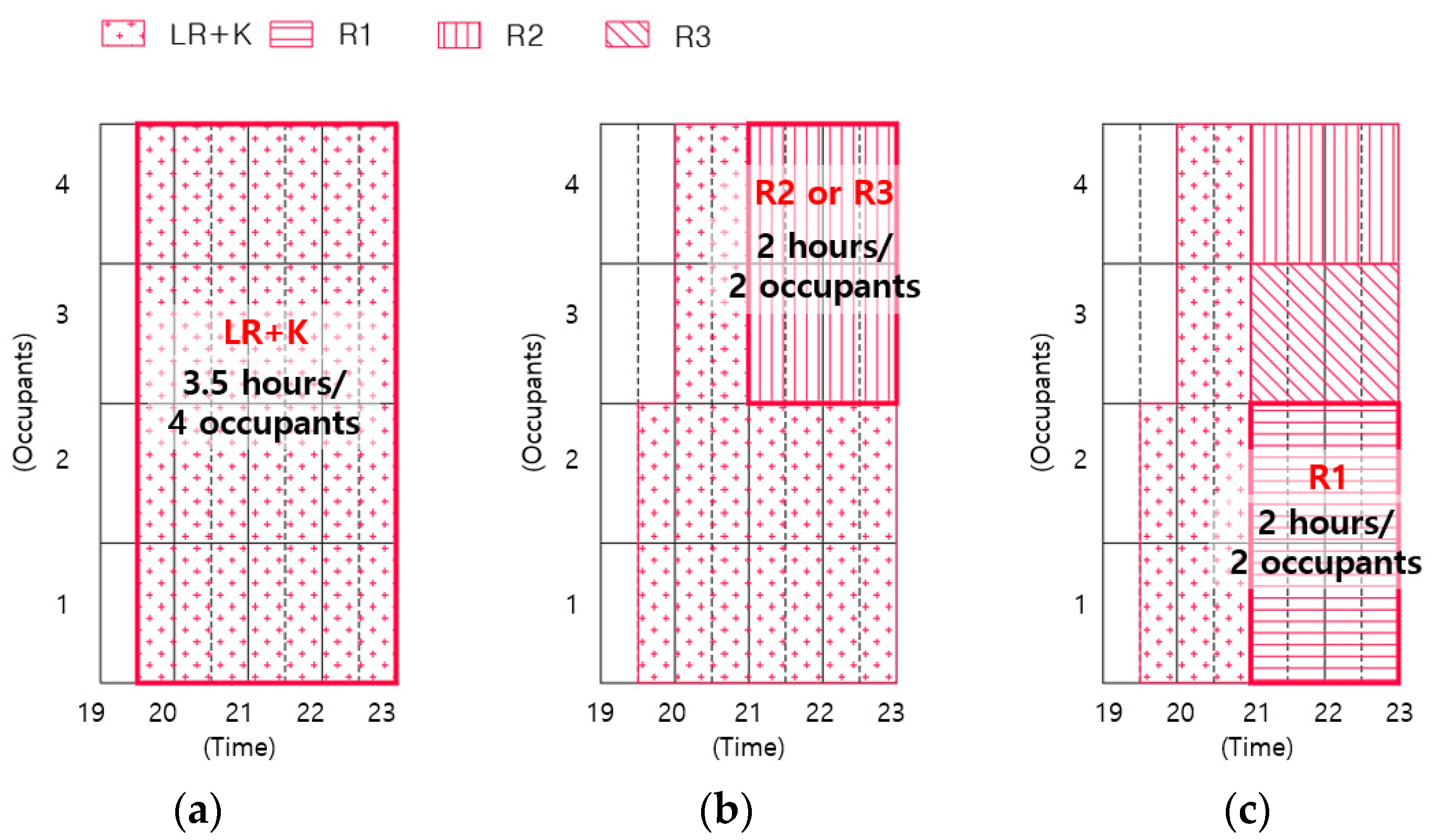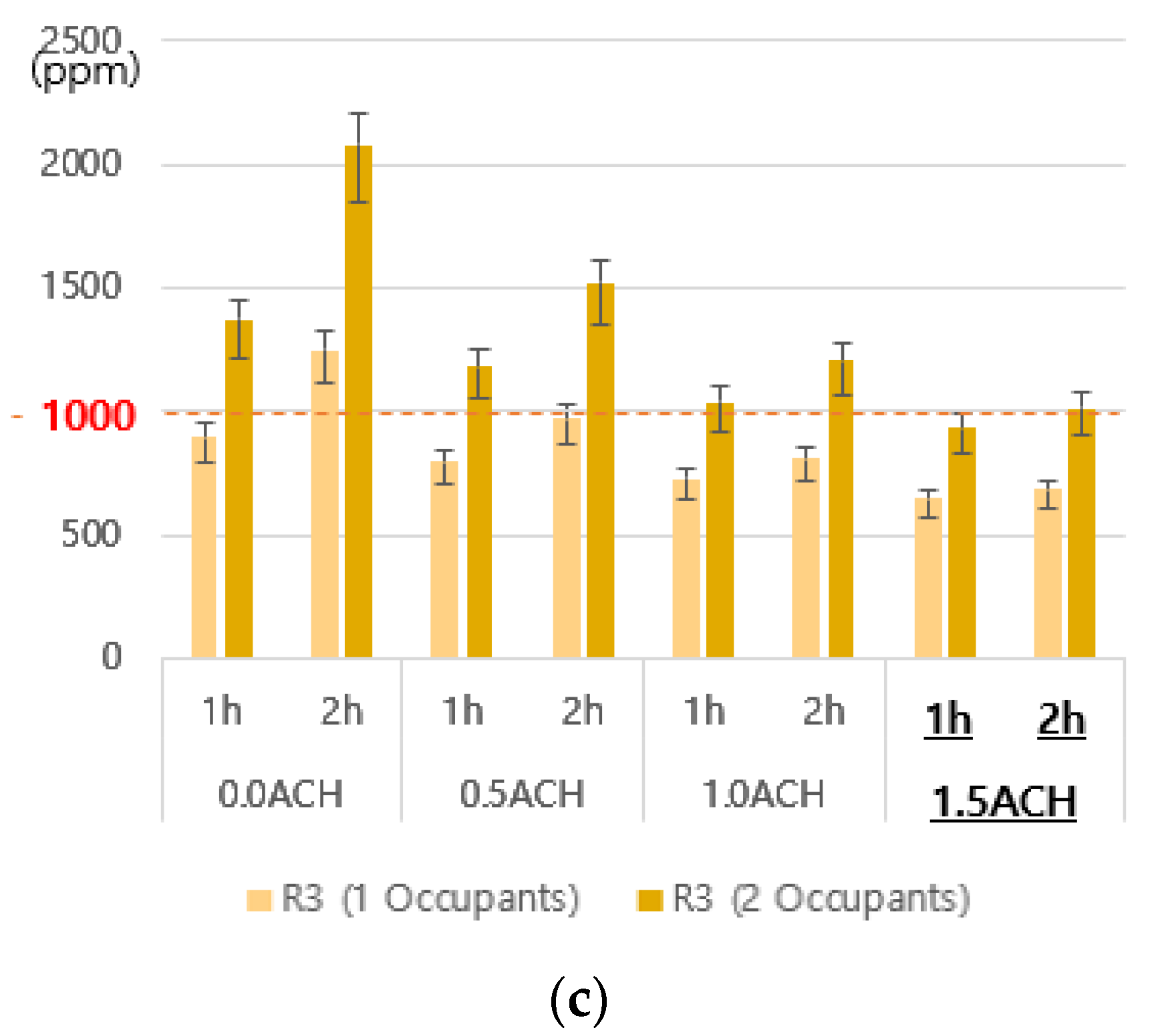Experimental Analysis of CO2 Concentration Changes in an Apartment Using a Residential Heat Recovery Ventilator
Abstract
1. Introduction
2. Materials and Methods
2.1. Experimental Sequence
2.2. Experiment Space and Measurement Equiptment
3. Results
3.1. Analysis of the Residence Time for Each Room
- The average bedtime for Korean people was 23:22 and the average wake-up time was 06:55, resulting in an average sleeping time of 7 h and 27 min. The average sleeping time of people older than 40 was 1 h less than that of their children. In other words, in the case of a four-member family, it was assumed that the couple slept for 7 h and the two children for 8 h each.
- Meal time ranged from 25 to 35 min, resulting in an average of 30 min. The preparation time for dressing and a shower before meals was assumed to be 30 min.
- School and working hours were from 09:00 to 18:00, and the average commute time was 1 h and 16 min. In this study, the commute time was assumed to be 1 h and 30 min.
- The couple goes to bed at 23:00 and wakes up at 06:00; the children wakes up at 07:00.
- The family leaves from home at 07:30 and works or studies from 09:00 to 18:00. They return to home at 19:30.
- The family has dinner for 30 min after a 30-min preparation allotment for dressing, and shower by approximately 20:30.
- Assuming that they spend 30 min to 1 h out of 2 h and 30 min before bedtime (23:00) with other family members, the practical continuous residence time in each room was estimated to be less than 2 h.
- As the target space is indoors, only light activities were assumed.
3.2. Analysis of the Infiltration Rate of Each Room
3.3. Mass Conservation Equation to Examine Indoor Air Pollution
- With no separate ventilation, Q can be considered as the infiltration volume.
- When mechanical ventilation was performed, the value obtained by adding the mechanical ventilation rate to the natural infiltration volume by the heat recovery ventilator was applied to Q. In this instance, the supply and return volumes were set to be equal by adjusting the speed of the supply and return fans before the start of the experiment. The values were examined using FMS in each room to minimize the influence of additional pressurization or decompression.
- In Equation (2), the amount of CO2 generated (G) was calculated to be 18 L/h for adult males and 16 L/h for adult females, in accordance with ASHRAE 62.1 (2019) and KS F 2603 (2016).
- No ventilation
- 0.5 ACH, which is the minimum ventilation frequency required by law
- 1.0 ACH, which is twice as high as the minimum required ventilation frequency
- With no ventilation in LR + K (0 ACH), the CO2 concentration could exceed 1000 ppm, if four people stayed for more than 1 h or two people stayed for more than 3 h.
- When a mechanical ventilation of 0.5 ACH was performed, the CO2 concentration could also exceed 1000 ppm, if four people stayed for more than 2 h.
- With no ventilation, the CO2 concentration could exceed 1000 ppm under all conditions except when one person stayed for less than 1 h. In the case of R2 and R3, the CO2 concentration could exceed 2000 ppm, if two adult males stayed for 2 h.
- When the minimum required 0.5 ACH ventilation was performed, the CO2 concentration in R2 with the lowest infiltration rate increased to 1089 ppm if one adult male stayed for 2 h and to 1757 ppm if two adult males stayed for 2 h. In particular, the CO2 concentration in R1, R2, and R3 exceeded 1000 ppm, if two adult males stayed for only 1 h.
- When a 1.5 ACH ventilation was performed, CO2 concentration could be maintained at a level lower than 1000 ppm in R1, R2, and R3, even if one occupant stayed for more than 2 h. However, the CO2 concentrations in R1, R2, and R3 exceeded 1000 ppm and reached 1130, 1361, and 1206 ppm, respectively, if two occupants stayed for 2 h.
- With a ventilation of 1.5 ACH, the indoor CO2 concentration ranged from less than 1000 ppm to slightly higher than 1100 ppm. The latter values occurred if two occupants stayed for 2 h, the most severe among the experimental conditions.
4. Discussion
- The room occupancy scenarios of a four-member family living in an 85 m2 apartment unit were examined using statistical data, and the residence time schedule for each room was prepared. The maximum number of occupants and the maximum residence time were found to be four people and 4 h, respectively, for LR + K, and two people and 2 h, respectively, for each of R1, R2, and R3.
- The infiltration rate for each room was obtained using the CO2 reduction method in accordance with KS F 2603. The CO2 concentration equation was then constructed for each case using the mass balance equation that combined these infiltration rates, and the error range was calculated by performing experiments under several conditions. In addition, the CO2 concentration was analyzed for various cases using this equation.
- For the minimum required ventilation of 0.5 ACH, analysis results showed that it was difficult to maintain 1000 ppm or less if four people stay for more than 2 h in LR + K and if two people stay for more than 1 h in R1, R2, and R3, which is the minimum ventilation frequency by law.
- Ventilation of 1.0 ACH or more was required for two people to stay in a bedroom for more than 1 h. Furthermore, 1.5 ACH or more was required for two people to stay for more than 2 h while maintaining a CO2 concentration of approximately 1000 ppm.
Author Contributions
Funding
Institutional Review Board Statement
Informed Consent Statement
Data Availability Statement
Conflicts of Interest
References
- Ministry of Land, Infrastructure and Transport (MLIT). Korean MLIT Decree No.704, Rules on the Facility Standards of Buildings; MLIT: Seoul, Korea, 2020.
- MLIT. Law No. 17921, Law for Apartment Housing; MLIT: Seoul, Korea, 2021.
- American Society of Heating, Refrigerating and Air-Conditioning Engineers (ASHRAE). Ventilation and Acceptable Indoor Air Quality in Residential Buildings; Standard 62.2; ASHRAE Inc.: Atlanta, GA, USA, 2019. [Google Scholar]
- National Research Council. Carbon Dioxide. In Spacecraft Maximum Allowable Concentrations for Selected Airborne Contaminants; National Academies Press: Washington, DC, USA, 2008; pp. 112–124. [Google Scholar]
- Health Canada. Indoor air quality in office buildings: A technical guide. In A Report of the Federal-Provincial Advisory Committee on Environmental and Occupational Health; Health Canada: Ottawa, ON, Canada, 1995. [Google Scholar]
- Ministry of Environment (MOE). Enforcement Rules of Indoor Air Quality Control; Korean MOE Decree No.918; Ministry of Environment: Seoul, Korea, 2021.
- Total Climate Change Monitoring Data, CO2 Concentration in Korea. Available online: http://www.climate.go.kr/home/09_monitoring/ghg/co2_global_trend (accessed on 21 March 2021).
- ASHRAE Inc. Ventilation for Acceptable Indoor Air Quality; ASHRAE Standard 62.1; ASHRAE Inc.: Atlanta, GA, USA, 2019. [Google Scholar]
- Read by Area and Analyzed by Space. Available online: https://www.sciencetimes.co.kr/news (accessed on 24 April 2021).
- Nam, K.; Lee, Y. An analysis on HCHO, TVOC, CO2, concentration of existing housing indoor air in summer. KIEAE J. 2016, 16, 115–122. [Google Scholar] [CrossRef]
- Nam, K.; Lee, Y.; Choi, B. A comparative analysis on concentration of pollutants in housing indoor air between winter and summer. KIEAE J. 2017, 17, 125–131. [Google Scholar] [CrossRef]
- Pavlovas, V. Demand controlled ventilation: A case study for existing Swedish multifamily buildings, Energy Build. REHVA Sci. 2004, 36, 1029–1034. [Google Scholar]
- Jreijiry, D.; Husaunndee, A.; Inard, C. Numerical study of a hybrid ventilation system for single family houses. Sol. Energy 2007, 81, 227–239. [Google Scholar] [CrossRef]
- Laverge, J.; Bossche, N.V.D.; Heijmans, N.; Janssens, A. Energy saving potential and repercussions on indoor air quality of demand controlled residential ventilation strategies. Build. Environ. 2011, 46, 1497–1503. [Google Scholar] [CrossRef]
- Seong, N. Energy requirements of a multi-sensor based demand control ventilation system in residential buildings. In Proceedings of the 31st AIVC Conference “Low Energy and Sustainable Ventilation Technologies for Green Buildings, Seoul, Korea, 26–28 October 2010. [Google Scholar]
- Mortensen, D.K.; Walker, I.S.; Sherman, M.H. Optimization of Occupancy Based Demand Controlled Ventilation in Residences. Int. J. Vent. 2011, 10, 49–60. [Google Scholar] [CrossRef][Green Version]
- Hesaraki, A.; Holmberg, S. Demand-controlled ventilation in new residential buildings: Consequences on indoor air quality and energy savings. Indoor Built Environ. 2013, 24, 162–173. [Google Scholar] [CrossRef]
- Nielsen, T.R.; Drivsholm, C. Energy efficient demand controlled ventilation in single family houses. Energy Build. 2010, 42, 1995–1998. [Google Scholar] [CrossRef]
- Kim, K.; Kim, M.; Kwon, O.; Seok, Y.; Jeong, J. Application of Demand Controlled Ventilation in Multifamily Houses Meeting the Current Korean Ventilation Standards. J. KIAEBS 2009, 3, 192–200. [Google Scholar]
- Statistics Korea. Life Time Survey Results; Social Statistics Bureau Social Statistics Planning Division: Seoul, Korea, 2019.
- Statistics Korea. Residential Status Survey. 2019. Available online: https://kostat.go.kr (accessed on 5 February 2021).
- Korean Standard. KS F 2603. In Standard Test Method for Measuring Indoor Ventilation Rate (Carbon Dioxide Method); Korean Standard: Seoul, Korea, 2016. [Google Scholar]
- Wallace, L.; Emmerich, S.; Howard-reed, C. Continuous measurements of air change rates in an occupied house for 1year: The effect of temperature, wind fans, and windows. J. Exp. Anal. Environ. Epidemiol. 2002, 12, 296–306. [Google Scholar] [CrossRef] [PubMed]







| Case | LR + K | R1 | R2 | R3 |
|---|---|---|---|---|
| Max | 0.37 | 0.61 | 0.25 | 0.41 |
| Min | 0.25 | 0.23 | 0.15 | 0.23 |
| Average | 0.33 | 0.41 | 0.20 | 0.30 |
| Volume (m3) | 102.1 | 33.8 | 29.0 | 32.6 |
| ACH_O * | LR + K E.V. (C.V.) (ppm) | Dif. (%) | R1 E.V. (C.V.)2 (ppm) | Dif. (%) | R2 E.V. (C.V.) (ppm) | Dif. (%) | R3 E.V. (C.V.) (ppm) | Dif. (%) |
|---|---|---|---|---|---|---|---|---|
| 0ACH_1 | 602(669) | −6 | 1002(1066) | −6 | 1459(1396) | +5 | 1231(1326) | −7 |
| 0ACH_2 | 931(966) | −1 | 1875(1873) | −1 | 2385(2372) | +1 | 2389(2458) | −3 |
| 0.5ACH_1 | 582(603) | −3 | 806(856) | −6 | 980(1088) | −10 | 982(1096) | −10 |
| 0.5ACH_2 | 710(756) | −6 | 1488(1400) | +6 | 1732(1757) | −1 | 1651(1772) | −7 |
| 1.0ACH_1 | 520(530) | −2 | 693(736) | −6 | 747(838) | −11 | 860(903) | −5 |
| 1.0ACH_2 | 630(667) | −5 | 1002(1130) | −11 | 1476(1361) | +6 | 1361(1385) | −2 |
Publisher’s Note: MDPI stays neutral with regard to jurisdictional claims in published maps and institutional affiliations. |
© 2021 by the authors. Licensee MDPI, Basel, Switzerland. This article is an open access article distributed under the terms and conditions of the Creative Commons Attribution (CC BY) license (https://creativecommons.org/licenses/by/4.0/).
Share and Cite
Cho, K.; Cho, D.; Kim, T. Experimental Analysis of CO2 Concentration Changes in an Apartment Using a Residential Heat Recovery Ventilator. Sustainability 2021, 13, 10302. https://doi.org/10.3390/su131810302
Cho K, Cho D, Kim T. Experimental Analysis of CO2 Concentration Changes in an Apartment Using a Residential Heat Recovery Ventilator. Sustainability. 2021; 13(18):10302. https://doi.org/10.3390/su131810302
Chicago/Turabian StyleCho, Kyungjoo, Dongwoo Cho, and Taeyeon Kim. 2021. "Experimental Analysis of CO2 Concentration Changes in an Apartment Using a Residential Heat Recovery Ventilator" Sustainability 13, no. 18: 10302. https://doi.org/10.3390/su131810302
APA StyleCho, K., Cho, D., & Kim, T. (2021). Experimental Analysis of CO2 Concentration Changes in an Apartment Using a Residential Heat Recovery Ventilator. Sustainability, 13(18), 10302. https://doi.org/10.3390/su131810302





